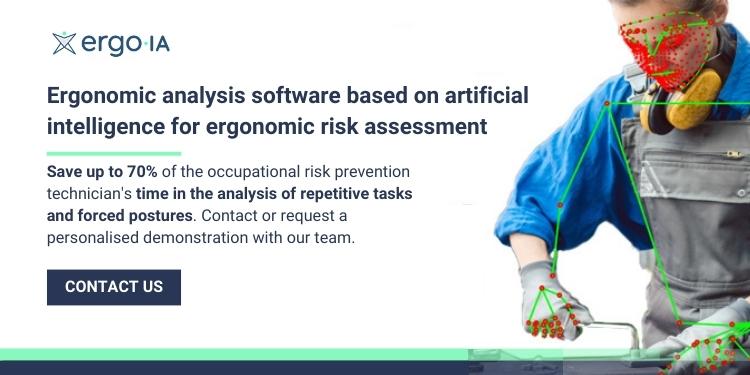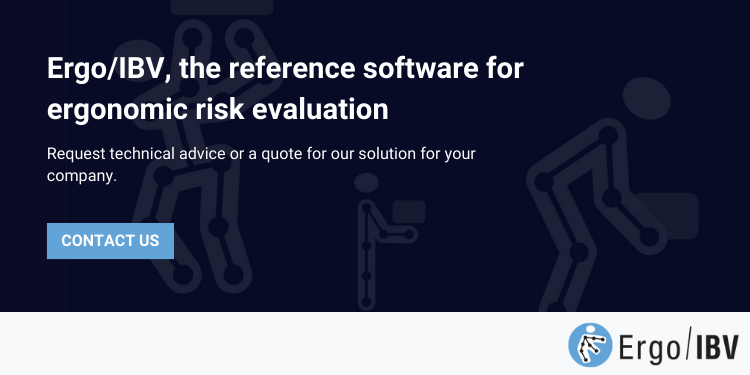Keys to preventing and assessing awkward postures
Awkward postures are one of the main causes of musculoskeletal disorders, the second most frequent cause of absenteeism in Spain, accounting for more than 25% of sick leave.
The figures are alarming: according to the European Agency for Safety and Health at Work, more than half of all workers have neck problems, 30% have shoulder tension and 26% suffer from wrist and arm pain.
In this article therefore, we explore the need to properly identify, prevent and assess the risks associated with awkward postures in the workplace. Find out how Ergo/IBV ergonomics software can help prevention officers in this task.
Awkward postures in the workplace: What are they?
When we talk about awkward postures in the workplace, we are referring to all physical positions that cause workers to no longer be in a neutral, natural and comfortable position.
This includes both fixed or constrained body positions and those that overload muscles, tendons and joints in an unbalanced way.
It also applies to static positions that keep muscles tensed without movement. Examples include bending or twisting the neck or torso, keeping arms raised above shoulder level, or performing wrist flexions, extensions or rotations.
Ergonomic hazards associated with awkward postures in the workplace
Ergonomic risk factors are those elements present in the work environment or in the requirements of the job that increase the probability of developing an injury or pathology, thus increasing the level of risk.
Risk factors for awkward postures
In the case of awkward postures, several risk factors should be taken into account:
- Body positions away from the neutral zone: adopting unnatural postures such as excessive bending, leaning to one side or prolonged twisting of areas such as the torso, neck and the lower and/or upper extremities.
- Frequency of movements: the high repetition of certain movements or postures increases the risk of injury.
- Duration of posture: maintaining an awkward posture for prolonged periods of time can create stress and tension in the body, increasing the likelihood of developing musculoskeletal problems.
You may also be interested in | Repetitive movements at work: risks, injuries and prevention
Stages in the development of injuries associated with awkward postures
The onset of disorders and injuries due to awkward postures can be divided into three stages:
- In the first stage, a feeling of pain and fatigue is experienced during working hours, which disappears once the working day is over.
- In the second stage, the symptoms are not limited to working hours only, but also persist at night, causing sleep disturbances that negatively affect the quality of rest. In addition, there is a decrease in work capacity due to the impact on the workers’ energy, focus and productivity.
- In the third and final stage, symptoms persist even during rest periods, becoming even more debilitating and problematic. The ability to perform basic tasks can be severely impaired, with the consequent significant impact on quality of life.
Musculoskeletal disorders due to awkward postures
Depending on the body area affected, various types of musculoskeletal injuries can be distinguished. The most common ones are listed below.
In the shoulders and neck we highlight:
- Rotator cuff tendinitis.
- Thoracic stenosis or costoclavicular syndrome.
- Cervical tension syndrome.
On the other hand, the most frequent pathologies in the hands and wrists are:
- Carpal tunnel syndrome.
- Trigger finger.
- Guyon’s canal syndrome.
In the arms and elbows, typical injuries as a consequence of awkward postures are:
- Epicondylitis and epitrocleitis.
- Round pronator syndrome.
- Cubital tunnel syndrome.
Risk prevention related to awkward postures
Adopting a prevention-focused strategy is vital to mitigate the high socio-economic costs of MSDs. In general terms, the regulations stipulate the need to adapt work to the individual, to choose appropriate equipment and work and production methods to achieve a variety of healthy postures, and to monitor workers’ health in a timely manner.
If we break down these general specifications into more specific preventive measures, we arrive at four basic indications:
- Rotate jobs and tasks: it is recommended that workers responsibilities be rotated to avoid continuous exposure to awkward movements and awkward postures.
- Take breaks during the working day: schedule regular breaks that allow workers to release tension and rest adequately is important to reduce muscle fatigue and prevent injuries related to awkward postures.
- Ensure sufficient free space: make sure that each worker has an adequate space of at least 2 square meters, which provides freedom of movement and avoids the feeling of confinement.
- Design the workstation ergonomically: this involves using appropriate furniture, such as adjustable tables and chairs, as well as work surfaces that are at the correct height and ensuring that materials and tools are within easy reach.
Assessing awkward posture risk in the work environment
There are several methods for assessing awkward posture risk in the workplace. These include REBA (Rapid Entire Body Assessment) and OWAS (Ovako Working Analysis System).
The REBA Method
The aim of this method is to identify and assess the most frequent and most painful postures performed during the performance of tasks.
Specifically, for each posture, it analyzes body positions, energetic efforts, type of movement or action, and the presence of repetition, sudden changes or an unstable base to determine the level of risk of musculoskeletal injuries for each body region. From the risk factor variables, a score is generated that represents the level of MSD risk, with an indication of severity and an indication of a level of action.
The OWAS Method
This method takes a global view of a representative sample of postures adopted in the performance of a task at regular intervals, not just individual postures.
It is useful for evaluating working days where the load is unevenly distributed or the exact exposure times are unknown, as it evaluates the accumulation of load on different parts of the body, as well as the most frequent combinations of risk postures.
Using Ergo/IBV software to improve the prevention of awkward postures in the workplace
Occupational risk assessment software is extremely useful for streamlining the process of job analysis, and it becomes a very effective tool in terms of prevention and task redesign.
Ergo/IBV’s software is a very effective tool in terms of prevention and task redesign. It unifies the main existing methods, provides guidance in selecting the most appropriate one for each situation and its database of multi-sector solutions provides tools to support the design and redesign of workplaces.
How to use REBA and OWAS
- Using the “REBA Postures” module involves describing the task to be assessed and identifying the postures of the person performing it, paying particular attention to the points where the body load is concentrated. The software assigns a score to each group of variables analyzed, analyzes the results and determines the level of ergonomic risk for each posture.
- The “OWAS Postures” module involves coding the postures of a work cycle at regular intervals by watching a video and selecting, for each of the postures inventoried, one of the position options proposed for each part of the body (back, arms and legs) and for the level of force exerted.
As you have seen, applying REBA and OWAS is easy if you have an effective occupational risk assessment software such as Ergo/IBV. Would you like us to provide you with advice regarding this solution? Contact Ergo/IBV and we will clear up all your doubts.



